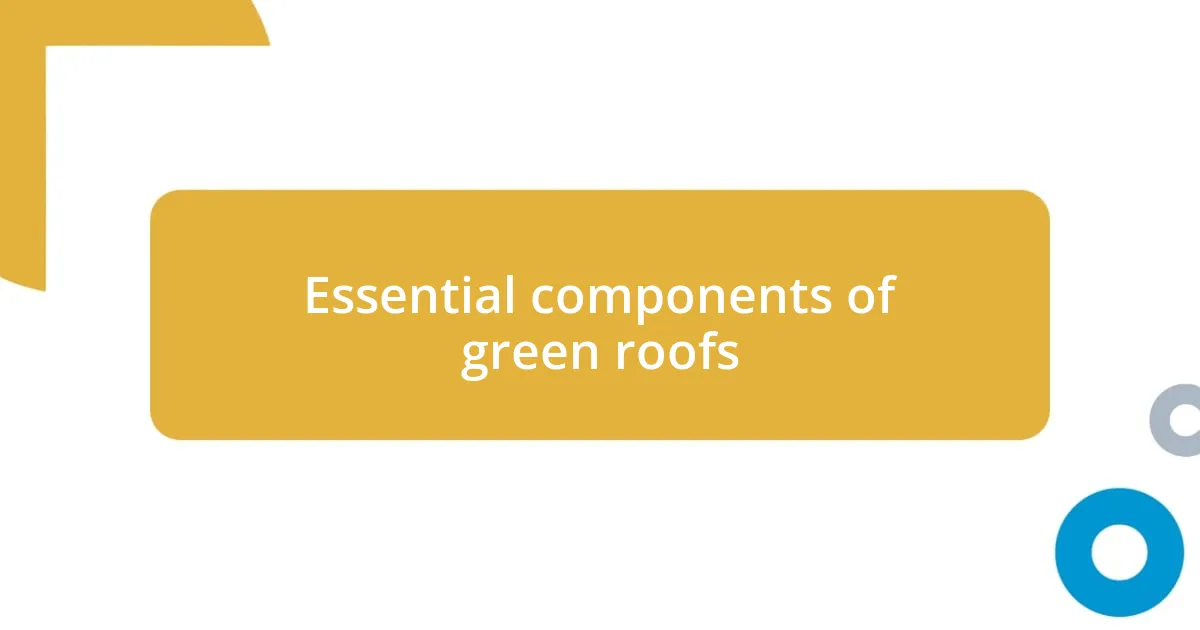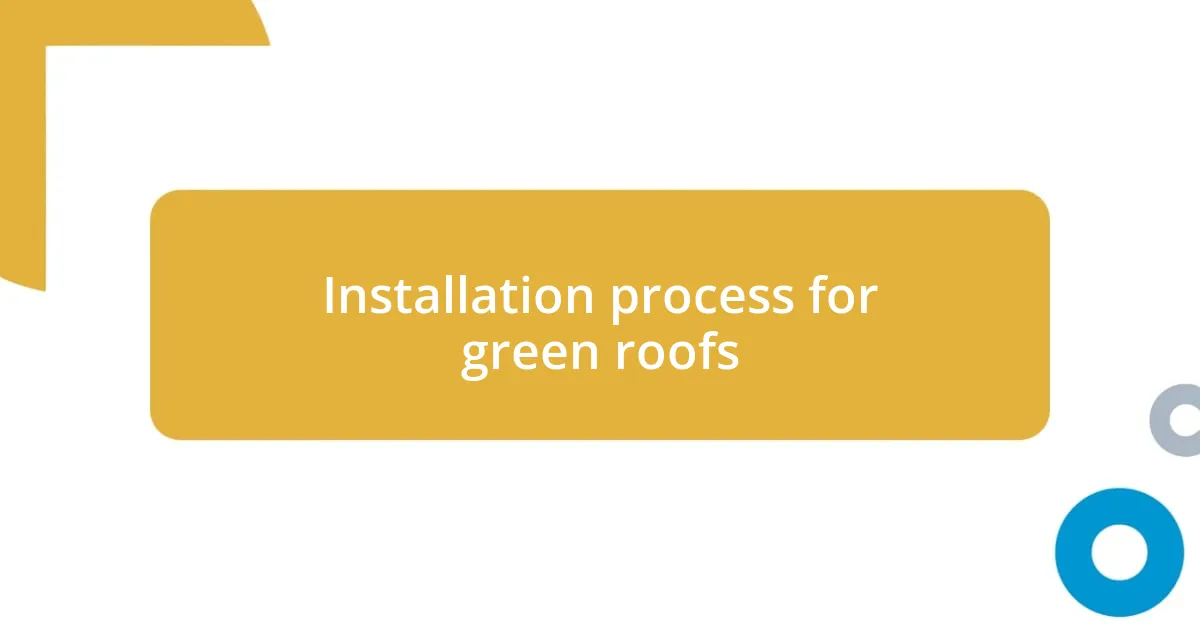Key takeaways:
- Green roofs enhance urban biodiversity, manage stormwater, and provide natural insulation, resulting in reduced energy costs.
- There are two main types of green roofs: extensive (lightweight, low-maintenance) and intensive (supports larger plants, requires more maintenance).
- Essential components of green roofs include the vegetation layer, growing medium, drainage layer, filter fabric, waterproofing membrane, and root barrier.
- Future trends in green roofing emphasize technology integration, biodiversity, and the use of sustainable materials.

Understanding green roofs benefits
One of the most evident benefits of green roofs is their ability to enhance urban biodiversity. I remember walking through the city and being genuinely surprised to see vibrant flowers and buzzing bees atop a skyscraper. It made me think—how can something designed for human use also play a crucial role in supporting wildlife?
In addition, green roofs play a significant role in managing stormwater. I once visited a building with a green roof during a heavy rainstorm. Watching the rainwater pool and recede slowly was fascinating. Rather than flooding the streets, it was like the roof was a sponge, absorbing water and reducing runoff. Isn’t that a brilliant way to tackle urban flooding?
Not to mention, green roofs provide natural insulation, which can lead to reduced energy costs. I’ve worked in buildings that had a green roof, and the difference in temperature during the summer months was remarkable. Feeling the cooler air inside made me wonder: how much energy could we save if more buildings harnessed this natural air conditioning?

Types of green roof systems
The two main types of green roof systems are extensive and intensive, each serving different purposes and featuring unique characteristics. Extensive green roofs are lightweight and typically require less maintenance. During a recent visit to an extensive green roof, I was amazed at how hardy plants like sedums thrived with minimal care, providing a lush green space without much input.
On the other hand, intensive green roofs offer a more diverse ecosystem, capable of supporting larger plants, shrubs, and even small trees. I remember stepping onto an intensive roof garden that felt more like a park than a building feature. It was vibrant and full of life, allowing people to cultivate a range of plants while also creating social spaces. This variety does come with more intensive maintenance, but the payoff is a truly engaging environment.
To put it all into perspective, it’s fascinating how each system caters to different needs. If you’re after low maintenance and environmental benefits, extensive roofs are the way to go. However, for a multifunctional space that supports recreational activities and diverse plant life, intensive roofs are unparalleled.
| Type | Characteristics |
|---|---|
| Extensive | Lightweight, low-maintenance, suited for hardy plants |
| Intensive | Heavy, requires more care, supports larger plants and recreational spaces |

Essential components of green roofs
The essential components of green roofs are what truly bring them to life, transforming a simple building top into a vibrant ecosystem. From my observations, I’ve found that having a solid structure is crucial, as it supports the weight of the layers above. I once found myself marveling at a beautifully designed green roof that felt nearly weightless, blending seamlessly with the skyline. It struck me how fundamental each layer is in creating this balance.
Here’s a breakdown of the components that comprise effective green roofs:
- Vegetation Layer: This is the lush green cover, often comprising drought-resistant plants, that thrives in the growing medium.
- Growing Medium: This soil-like substrate retains moisture and nutrients, creating a healthy environment for plants. I’ve seen how different compositions can affect plant health dramatically.
- Drainage Layer: This layer ensures excess water flows away, preventing root rot and maintaining optimal moisture levels.
- Filter Fabric: Placed above the drainage system, it prevents soil erosion while still allowing water to pass through. I’ve walked on roofs where the fabric seemed invisible yet did its job flawlessly.
- Waterproofing Membrane: Protecting the building from water damage, this membrane is essential; without it, even the most beautiful greenery could lead to costly repairs.
- Root Barrier: This prevents plant roots from penetrating and damaging the waterproofing layer, keeping the building safe over time.
Understanding these components gives you insight into the delicate ecosystem that resides above us. I often ponder how much care and thought goes into such structures, and witnessing the interaction between nature and urban architecture truly fascinates me.

Installation process for green roofs
The installation process for green roofs requires careful planning and execution to ensure long-lasting beauty and functionality. From my experience, it begins with assessing the building’s structure; this is crucial since the additional weight of the green roof must be supported without compromising the integrity of the building. I remember a project where we had to reinforce the structure first, and watching the transformation unfold was exhilarating.
Once the foundation is sound, it’s time to lay down the waterproofing membrane. This layer acts as a protector, safeguarding the building from moisture damage. I’ve worked on roofs where the installation of this membrane felt like sealing a treasure chest, knowing what beautiful treasures would flourish above it – a layer of soil, plants, and life. It’s a vital step, yet it often feels overlooked until one realizes its importance after a heavy rain.
Finally, the fun begins with the vegetation layer! Choosing the right plants based on climate and desired aesthetics is key. I recall helping to select vibrant flowers for an intensive roof garden, and seeing those plants come to life under the sun was immensely rewarding. It’s not just about installation; it’s about creating a space that breathes, grows, and evolves with the seasons. How fulfilling is it to witness not just a roof, but an entire ecosystem flourish right above us?

Maintenance tips for green roofs
Maintaining a green roof is essential for its longevity and effectiveness. One of the key aspects I’ve learned is the importance of regular inspections. Each season brings its own challenges, whether it’s fallen leaves in autumn or snow accumulation in winter. I recall a particular winter when I neglected to clear some snow from a green roof I managed. Let me tell you, the following spring, the plants struggled to recover, serving as a poignant reminder of how proactive care can prevent bigger problems.
Another vital maintenance tip is checking the irrigation system and ensuring it functions properly. In my experience, a well-timed watering schedule not only supports plant health but also enhances the roof’s aesthetic appeal. Once, I experimented with a drip irrigation system, and it was an absolute game changer—like providing a refreshing drink to thirsty plants on a hot summer day. The colors transformed, and the life on the roof became so vibrant that I couldn’t resist spending more time up there, enjoying the views.
I can’t stress enough the significance of weeding. While it might seem like a mundane task, I’ve found that removing invasive species helps maintain balance in the ecosystem. I remember tackling a particularly stubborn patch of weeds that had popped up unexpectedly. As I pulled those weeds, I felt a connection to the roof’s health and beauty; it was almost meditative. Keeping the right plants thriving can turn your green roof into a lush, inviting sanctuary. Have you ever felt that sense of accomplishment after beautifying a space you care about? It’s truly a gratifying experience, and that’s what green roofs are all about.

Common challenges with green roofs
One of the common challenges I’ve encountered with green roofs is managing water drainage. In multiple projects, I noticed that improper drainage can lead to water pooling, which not only harms the plants but can also compromise the structural integrity of the roof. I remember a rooftop garden that started to resemble a small pond after a heavy rainfall. The sight was disheartening, but it taught me a valuable lesson about the necessity of engineered drainage systems.
Plant selection is another hurdle. I’ve often found that choosing plants suited to the local climate and environmental conditions is crucial, yet it’s not always straightforward. There was a time when I selected a beautiful variety that thrived in theory, but in practice, the intense summer heat proved too much for them. It made me think—how often do we overlook the importance of compatibility when creating our green spaces? I realized that understanding local ecosystems is vital.
Lastly, maintenance often becomes more challenging as time goes on. I recall sharing a green roof with a friend where we decided to grow herbs and flowers. Initially, it was all fun, but as the seasons changed, keeping up with growth became overwhelming. Have you ever embarked on a project that seemed simple at first but turned into a labor of love? I learned that simplicity in design does help mitigate maintenance—it’s a lesson that keeps shaping my future green roof endeavors.

Future trends in green roofing
As I look towards the future of green roofing, one exciting trend is the increasing integration of technology. I’ve recently started exploring smart sensors that monitor soil moisture and temperature, providing real-time data to optimize watering. Imagine being able to adjust irrigation from your phone; it feels like bringing a touch of the future to our gardens. Have you ever wished for such convenience in your own gardening efforts?
Another noteworthy direction is the focus on biodiversity. I’ve come to realize that fostering a diverse ecosystem on a green roof enhances its resilience and appeal. I remember one project in an urban setting where we planted a variety of native species. Not only did the roof attract more pollinators like bees and butterflies, but the vibrant array of plants also painted a beautiful picture against the city skyline. Isn’t it amazing how a small green space can play a vital role in promoting local wildlife?
Finally, I’ve seen a growing emphasis on sustainable materials and construction practices in green roofing. The more I delve into this topic, the more I appreciate how recycled materials or locally sourced resources can impact the overall environmental footprint of a project. I once used reclaimed wood for a roof structure, and it not only added character but also reminded me of the importance of resourcefulness. How often do we think about the story our materials tell? By choosing wisely, we can contribute to a brighter, more sustainable future for our urban spaces.












